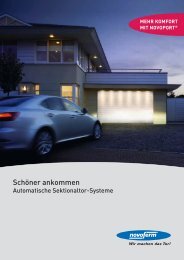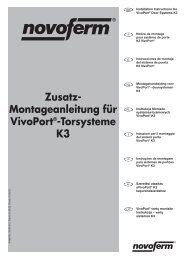D - Novoferm
D - Novoferm
D - Novoferm
Create successful ePaper yourself
Turn your PDF publications into a flip-book with our unique Google optimized e-Paper software.
Installation Instructions<br />
Installation should only be carried out by persons<br />
qualified to do so !<br />
Incorrect installation can put the safety of persons<br />
at risk or cause damage to property!<br />
Improper installation shall exempt the<br />
manufacturer from all liability.<br />
Preparing for installation<br />
1. To connect to the mains, a power point must be<br />
installed on site - the included mains lead is<br />
approx. 1 m long.<br />
2. Check the stability of the door, retighten the<br />
screws and nuts on the door.<br />
3. Check that the door is running smoothly and is<br />
in good working order, lubricate the shafts and<br />
bearings. Check the pretension of the springs<br />
and, if necessary, re-adjust.<br />
4. Dismantle the existing door latches (bolt plate<br />
and catches).<br />
5. For garages without a second entrance, an<br />
emergency release is required (accessory).<br />
6. If a wicket door is included, fit the wicket door<br />
contact.<br />
7. Check the supplied screws and wall plugs to<br />
ensure that these are suitable for the structural<br />
conditions on site.<br />
0 Required tools<br />
- Drilling machine with 6 mm masonry drill<br />
- Sturdy side cutter<br />
- Wrench, sizes 13, 15 and 17mm<br />
- Slotted screwdriver, 3 mm wide<br />
- Phillips screwdriver, size 2 x 100 mm<br />
1 Choosing the installation side<br />
Choose the installation side in accordance with the<br />
structural conditions on site. The standard<br />
installation side is on the right (as viewed from the<br />
inside) 1a. For special installation situations see 25<br />
and 26 . Dismantle the top track roller and roller<br />
block on the door (operator side) and fit the<br />
supplied roller block 1b.<br />
Spray the track with silicone to achieve optimum<br />
running qualities.<br />
2 Fitting the toothed belt<br />
The top door track is used for installing the drive<br />
unit. Place the toothed belt with prefitted end clamp<br />
in the track (back of toothed belt facing upwards).<br />
Slot end clamp with hook onto vertical formed end<br />
piece 2a.<br />
To disengage the drive wheel, actuate the lever 2b.<br />
Feed the toothed belt through the drive wheels of<br />
the motor head as shown in 2c.<br />
Insert drive unit with the drive wheels into the top<br />
track 2d.<br />
Inserting the limit stop (2e)<br />
Position the limit stop at a distance of 50 cm<br />
(ordering height) from the frame under the toothed<br />
belt.<br />
The limit stop should stop the operator approx.<br />
5 cm above the desired open position.<br />
Push end of toothed belt through the opening in<br />
the end assembly angle.<br />
3 Fitting the rear toothed belt fastening<br />
Feed the toothed belt through the end assembly<br />
angle and keep it taut 2a. Slot sleeve halves, as<br />
shown in 3a to 3c, onto the toothed belt. Attach<br />
knurled nuts 3d and turn to tension the toothed belt<br />
by hand. Make sure that you do not twist the<br />
toothed belt in the process. If the toothed belt<br />
overhangs, it can be shortened 3e.<br />
4 Inserting the top track roller<br />
Select the top track roller in accordance with the<br />
door type 4a.<br />
Insert the track roller into track 4b, adjust and<br />
screw on in accordance with figure 4c. In the case<br />
of an HL door, fit track roller obliquely as shown in<br />
figure 4c.<br />
5 Fastening the door bracket<br />
Place the door bracket on the designated drill<br />
holes of the top door leaf section and screw down<br />
with 3 self-tapping screws 6.3 x 16.<br />
6 Inserting the lifting arm<br />
Slot the lifting arm onto the bolt of the motor head<br />
6a and secure with clip. Hold the other side of the<br />
lifting arm between the door bracket and select<br />
hole setting 6b (VL setting for construction years<br />
prior to 2006).<br />
Push the bolt all the way through and secure with<br />
clip. Connect door to operator 6c.<br />
7 Sliding block<br />
Slot the sliding block onto the track profile, push<br />
into the rear opening on the motor head and screw<br />
down with screw 4.2 x 13.<br />
8 Mains connecting cable<br />
The back of the control unit includes a chamber 8a,<br />
where, if required, the excess mains lead can be<br />
stowed 8b.<br />
9 Connecting the coiled cable<br />
At the back of the control unit there is a cable<br />
clamp 9a for the two individual wires.<br />
Insert red wire on left (1) and green wire (2) on<br />
right into the clamp 9b. Insert plug into designated<br />
socket and allow to engage 9c. Afterwards, feed<br />
the cable through the labyrinth 9d.<br />
10 Fastening the control unit<br />
Install the control unit onto the side wall. At a<br />
distance of approx. 1 m from the door and 1.50 m<br />
from the floor, mark the spot for the first plug hole<br />
10a, drill the hole, insert the plug but do not screw<br />
in fully. Place the control unit with key hole onto the<br />
screw head. Align the unit and mark the remaining<br />
fixing holes 10b, drill holes, plug and fasten with<br />
screws 4.2 x 32.<br />
11 Wall clamp<br />
Hold up the coiled cable in a vertical position. The<br />
maximum extension of the horizontally routed<br />
cable may not exceed three times the original<br />
length. Attach the wall clamp at the bend. Hold the<br />
clamp against the wall, mark the spot, drill, plug<br />
and screw to the wall using screw 4.2 x 45.<br />
12 Connecting plan / aligning the aerial<br />
Hinweise:<br />
Notes:<br />
- Do not connect any current-carrying cables,<br />
only connect volt-free push buttons and voltfree<br />
relay outputs.<br />
- Before initial operation, test the function and<br />
safety of the operator (see section<br />
“Maintenance and Checks”).<br />
e. Connection for aerial<br />
Route the aerial on the housing exit upwards 12.<br />
When using an external aerial, the shielding<br />
must be assigned to the adjacent terminal (F, on<br />
right).<br />
f. Connection for external impulse generator<br />
(accessories, e.g. key switch or digital coder)<br />
g. Input STOP A<br />
Connection for safety devices (accessories, e.g.<br />
wicket door contact). An interruption at this input<br />
end causes the door to stop during the opening<br />
or closing phase or prevents the operator from<br />
starting up in either direction.<br />
h. Input STOP B<br />
Connection for safety devices (accessories, e.g.<br />
one-way photocell). An interruption at this input<br />
end causes the operator to automatically<br />
change direction during the closing cycle only.<br />
I. Voltage supply 24 V ~<br />
(e.g. for one-way photocell), connection can<br />
take a max. load of 100 mA (do not exceed!)<br />
j. Plug-in base for radio receiver<br />
k. Connection for an external light, protected light<br />
or signal lamp (protection classification II, max<br />
500W).<br />
13<br />
Lamp shade<br />
The lamp shade conceals the terminal<br />
connections. To do this, feed the back part of the<br />
lamp shade underneath the guides of the control<br />
unit 13a. Fasten the lamp shade with two selftapping<br />
screws 4.2 x 16 13b.<br />
14<br />
GB<br />
Control elements<br />
The control elements for programming the door<br />
operator are located behind the white cover. The<br />
cover can be opened with a screwdriver 14a.<br />
Once the operator has been programmed, the<br />
cover is reclosed and serves as an interior pushbutton<br />
23.<br />
A. The numerical display serves to indicate the<br />
menu stage, the respectively set value and the<br />
error / fault diagnosis.<br />
a. The incremental display, lights up to indicate<br />
readiness for operation and flashes on<br />
acknowledgement of learned hand transmitter<br />
codes.<br />
B. During the setting / adjustment phase button<br />
serves as an "UP" button and outside the menu<br />
as a START button.<br />
C. During the setting 7 adjustment phase button<br />
as a "DOWN" button.<br />
D. Button serves to call up the settings /<br />
adjustment menu, to change the menu stages<br />
and store the settings.<br />
Programming the control unit is menu-driven.<br />
Pressing button , calls up menu prompting. The<br />
numbers displayed indicate the menu stage. After<br />
approx. 2 seconds, the display flashes and the<br />
setting can be altered via buttons and<br />
verändert werden. The selected setting is stored<br />
via button and the programme automatically<br />
jumps to the next menu stage. By repeatedly<br />
pressing the button , menu stages can be<br />
skipped. To quit the menu, repeatedly press button<br />
until "0" is displayed again. Outside the menu,<br />
button can be used to generate a start impulse.<br />
Retain these installation, operating and maintenance instructions for the full duration of the operator’s service life!





